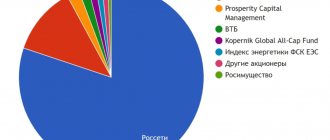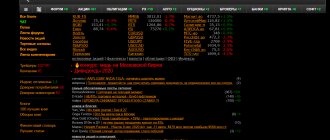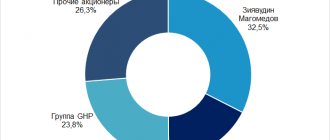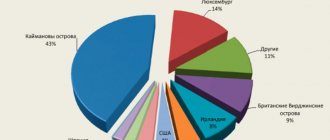Order of the Ministry of Finance of Russia dated July 22, 2003 No. 67n (read the commentary in No. 9 “BUKH.1S” for 2003) approved a new sample profit and loss statement (form No. 2), taking into account the requirements of paragraph 27 of PBU 4/99 “Accounting statements organization" on the need to reflect information on profit per share in reporting. The “For reference” section of this sample provides indicators of basic earnings (loss) per share and diluted earnings (loss) per share*. In the proposed article by V.V. Patrov, Doctor of Economics, Professor of St. Petersburg State University, discusses the procedure for calculating these indicators using specific examples.
Note:
* The indicated indicators are calculated in accordance with the Methodological Recommendations for Disclosure of Information on Profit per Share, approved. by order of the Ministry of Finance of Russia dated March 21, 2000 No. 29n.
Formula for calculating Earnings per Share (EPS)
The approach to calculating basic earnings per share EPS is fixed in international financial reporting standards: GAAP, IAS 33. In the domestic standard - RAS, this indicator is not presented. The calculation formula (EPS or Basic EPS) is as follows:
If the number of shares changed during the period under review (month, half-year, year), then the weighted average number of shares is used.
When calculating earnings per share, dividend payments are subtracted from the numerator because this part of the net profit goes to shareholders and is not used to develop the company or pay off debts and increase its financial stability.
Determination of net profit
How to calculate net profit?
We should start with the basics, and one of the most important economic indicators of the success of an enterprise is net profit - the funds remaining at the company's disposal after paying staff and paying all fees, taxes and bank and other deductions.
From these funds reserve funds and other savings are formed, and net profit is also used for the expansion and development of the enterprise.
Net profit and economic profit should not be confused. Their differences will be explained below.
Diluted EPS
There are a number of instruments (convertible bonds, options and warrants) that can be converted into shares (called potential common shares).
As a result, this leads to capital dilution due to an increase in the number of shares and a change in earnings per share. The calculation formula is as follows:
Diluted EPS is used for companies with complex capital structures.
If the conversion of potential common shares results in increased earnings, they are considered anti-dilutive and are excluded from the calculation.
Forward EPS
This modification of the indicator is more rare and shows projected earnings per share. The formula for calculating the coefficient is as follows:
The indicator is of interest, first of all, to investors, as it allows them to assess the growth in the attractiveness of shares. As a rule, the forecast is carried out for a quarter, a year and 5 years.
| Meaning | Grade |
| Forward EPS ↑ | Increasing the investment attractiveness of the company |
| Forward EPS ↓ | Decrease in attractiveness |
(-) the disadvantage of the forecast EPS is its subjectivity, because assessments are made to experts and for a fairly long period. You can view the forecast EPS in the Finviz service
EPS manipulation
Because EPS has a strong influence on investor decisions, its value can be manipulated. Manipulation can occur due to an increase in net profit due to severe cost cutting, sale of part of the business, or buy back of shares. As a result, in the long term, this reduces the company's performance, but in the short term, it increases interest in the company's shares in the stock market.
This strategy was used by the “activist investor” K. Aiken, who bought controlling stakes. After that, he put pressure on the board of directors and changed the company's policies. He was forced to make decisions that were not effective for the company: reducing costs by firing staff, selling assets, repurchasing shares at an inflated price.
Revenue for a certain period
The main indicator of net profit is revenue for a certain period. It consists of the money that your company receives for the sale of goods or services, investment and financial activities.
To analyze this indicator, you should choose the right period - if it comes to production, especially mass production, then it is reasonable to analyze revenue for a whole year or quarter.
As for more “dynamic” areas of business, such as sales or the provision of services, it makes sense to pay attention to revenue for the week, month or certain seasons when a particular product or service is in high demand.
How can you influence your revenue? If demand exceeds supply, revenue increases by increasing production. In the opposite situation, you need to create advantages for your products and services over competitors.
If your company is engaged in retail trade, then in order to increase revenue it is necessary to increase the attractiveness for consumers not only of the goods themselves, but also of the store in which they are sold.
Example of EPS calculation for Russian shares
In Russian financial statements there is no separate line reflecting EPS values. Therefore, for the calculation it will be necessary to determine the amount of net profit in the financial results statement and the number of ordinary shares traded on the stock market in the company’s card on the Moscow Exchange.
Let's calculate EPS for (GAZP). To do this, you need to go to the official website in the “Information Disclosure” section → Reporting. In the Financial Report we look at the amount of net profit (line 2400).
To find out the number of shares, you need to go to the MICEX website to the company’s information card → information on finding the volume of issue of ordinary shares.
In order to speed up the calculation, you can use the smart-lab service. It shows the ranking of companies with the highest earnings per share ↓
It is impossible to compare companies based on earnings per share, because... the meanings can differ hundreds of times, but the attractiveness is no greater. It is necessary to consider dynamics for one company
Source: smart-lab
Information on earnings per share [p.281]
Closed joint-stock companies and other organizations whose shares or financial instruments on them are not traded on the free securities market are not required to apply IFRS 33. But if they provide information on earnings per share in their financial statements share, they are required to disclose this information based on the said Standard. This ensures that the financial statements of different companies are comparable. [p.281]
INFORMATION ABOUT EARNINGS PER SHARE [p.375]
The requirements for the calculation and disclosure of earnings per share are set out in IAS 33 Earnings per share. The standard was approved by the IASB Council in January 1997 and revised in December 2003. The amendments are effective from 1 January 2005 [p.294]
Analysis of market dynamics has its roots in the last century, when industry analysis and analysis of the financial condition of the issuer did not yet exist. This was due to the fact that detailed financial information was not available to shareholders and a wide range of investors. Industry aggregates were not calculated, balance sheets, income statements, sales forecasting data, earnings per share data, and price/earnings ratios (P/E) were not published. Therefore, the only object that could be studied under these conditions was the stock market as such. Then some analysts began to use detailed charts to monitor market processes. These charts primarily showed when large investors entered into transactions or exited the market; the chart data helped in making profitable decisions to buy shares. The charts reflected the dynamics of stock prices, and analysts believed that it was the rates and their changes that gave certain indications of when it was best to sell.
Direct and indirect observations have shown that reported and forecast earnings per share have a direct impact on the price of ordinary shares; they are of interest to individual investors, although, in accordance with the theory of market efficiency, additional profit cannot be obtained on the basis of these information. The average form of market efficiency (where the stock price fully reflects publicly available information about the firm) assumes that this information is already reflected in the stock price. [p.213]
From the point of view of current publicly available comparative information on the price of shares of the acquiring and acquired companies and the profit per unit of investment made in their shares, when purchasing a large block of shares of the acquired company, one may temporarily get the impression that per ruble (dollar) of these investments profits and the price of the acquired company is less than the level of the same indicators that were characteristic of the acquiring enterprise (“Cash” (to assess the qualitative characteristics of the issuer from the point of view of the shareholder, its potential for paying dividends is important) the amount of current assets and the amount of current liabilities date of balance sheet information. Category 14 is devoted to capital structure, since it allows the investor to assess the amount of capital of the company received through loans and equity issues. The data presented in it cover the amount of long-term debt, the number of preferred and common shares outstanding. Section 15 shows earnings per share for the series previous reporting years and the last 12 months. Additional information about the state of this indicator, which is most important for the shareholder, can be obtained from section 16, which provides interim indicators of earnings per share for 3 or 6 months, which actually developed in the previous two reporting years. [p.117]
At that time, there was little information about the situation in the stock market. Investors relied, rather, on rumors (which in many cases they created themselves). There was no civilized stock market at that time. But Livermore did not rely on rumors, rightly believing that he could use information about fluctuations in stock prices to make profits from working in the market. He had a photographic memory and incredible mathematical skills and was able to remember all the historical price movements of the stocks he tracked. And based on these data, he could determine the most rational trade structure. In fact, Liver-[p.11]
This opinion specifies that earnings per common share should be presented on the Income Statement. As shown in table. 16.3, this data is recorded immediately after the information on net profit. The amount of earnings per share must be divided into (1) earnings from ongoing operations (2) earnings excluding the effects of extraordinary events and changes in accounting practices (3) the total effect of changes in accounting practices, and (4) net income. If a firm had gains or losses from discontinued operations or from extraordinary events, those gains or losses per share must also be presented on the Income Statement. [p.299]
Ordinary shares are included in the calculation of their weighted average number from the moment the rights to ordinary shares arise from their first owners, with the exception of the cases provided for in paragraph 7 of the Methodological Recommendations for the disclosure of information on profit per share. [p.24]
A joint stock company discloses information about profit per share in two amounts: basic profit (loss) per share, which reflects part of the profit (loss) of the reporting period attributable to shareholders - owners of ordinary shares, and profit (loss) per share, which reflects a possible decrease in the level of basic earnings (increase in loss) per share in the subsequent reporting period (hereinafter referred to as diluted earnings (loss) per share). [p.33]
If a joint-stock company does not have convertible securities or contracts specified in clause 9 of the Methodological Recommendations for disclosing information on profit per share, then only basic profit (loss) per share is reflected in the financial statements with mandatory disclosure of relevant information in the explanatory note . [p.33]
Profit dilution is understood as its decrease (increase in loss) per one ordinary share as a result of the possible future issue of additional ordinary shares without a corresponding increase in the company’s assets, except for the cases provided for in clause 7 of the Methodological Recommendations for the disclosure of information on profit per share. share. [p.34]
When determining a possible increase in profit, all expenses (income) related to the above-mentioned convertible securities and contracts that the joint-stock company will cease to carry out (receive) are taken into account in the event of conversion of all convertible securities into ordinary shares and execution of the contracts specified in clause 9 Methodological recommendations for disclosing information on earnings per share. [p.34]
When determining diluted earnings (loss) per share, the values of basic earnings and the weighted average number of ordinary shares outstanding, used in the reporting period when calculating basic earnings per share, are adjusted by the corresponding amounts of the possible increase in these values in connection with the conversion of all convertible shares into ordinary shares. securities of a joint-stock company and execution of contracts specified in clause 9 of the Methodological Recommendations for disclosing information on profit per share. [p.34]
Analysis of market dynamics has its roots in the last century, when industry analysis and analysis of the financial condition of the issuer did not yet exist. This was due to the fact that detailed financial information was not available to shareholders and a wide range of investors. Industry aggregates were not calculated, balance sheets, income statements, sales forecasts, earnings per share, or multiples of earnings (PIE) were not published. Therefore, the only object that could be studied under these conditions was the stock market as such. Then some analysts began to use detailed charts to monitor market processes. These charts primarily showed when large buyers entered or exited transactions, and the chart data helped in making profitable stock purchasing decisions. The charts reflected the dynamics of stock prices, since analysts believed that it was the rates and their changes that gave certain indications of when it was better to sell or buy shares of a particular issue. The same principle underlies modern technical analysis. Its proponents advocate the view that internal market parameters such as trading volumes and rates often indicate future market directions even before they are revealed through financial indicators. [p.384]
Paragraph 27 of PBU 4/99 requires that the financial statements of joint-stock companies reflect information on profit per share. In accordance with the order of the Ministry of Finance of the Russian Federation dated March 21, 2000 No. 29n, Methodological recommendations for disclosing information on earnings per share1, developed on the basis of IFRS 33 Earnings per share, were approved. These Methodological Recommendations have been put into effect since the financial statements of 2000 [p.193]
Order of the Ministry of Finance of the Russian Federation dated March 21, 2000 M 29n approved Methodological recommendations for the disclosure of information on earnings per share, which will create conditions for a more complete use of the EPS indicator in the practice of Russian financial management. [p.168]
A marketing manager evaluates the effectiveness of promotional activities by measuring sales and profits before, during, and after promotional activities. A non-financial manager can track which buyers use coupons and reply ards when purchasing goods. Since the activities of competitors affect the enterprise, they should be analyzed. Information about promotional costs helps make decisions regarding future channel choices to reach customers. [p.187]
The descriptive part of this material begins with data on the current exchange rate (I), the multiple of profit ratio (P/E) (II), showing the “price” of one unit of net profit. In Value Line reviews, it is customary to calculate this indicator as the quotient of the current stock price divided by the average net profit per share, in which the actual net profit is taken for the last six months and at the same time the forecast net profit per share for the next 6 months is taken into account. This section II also provides the average value of the P/E ratio, calculated on the basis of four averages, selected, in turn, from a number of averages for the last 10 years. The next section, III, again addresses this same indicator, but it is now presented as a relative value or through the share of the company's current P/E indicator in the average value of the P/E indicator for all stocks included in the Take Line review. . Section IV provides a forecast indicator of the current return on shares by “Is-insiders”, i.e. occupy official positions in the country itself. This describes the latest transactions of the directors and managers of the company in the purchase and sale of shares of Kodak, about which they are required by US law to file reports with the Securities and Exchange Commission. Column D 6 reflects the decisions and transactions in Kodak shares made by major financial institutions over the last 5 quarters, the number of shares involved in these transactions (the top two rows of this column), and the total number of Kodak shares they own (the last line of this section). The share of financial institutions in the share capital of the issuer is often considered as one of the important parameters of the risk of liquidity of its shares on the principle that the higher the share, the higher their liquidity, the lower the risk for the investor. Section D 7 gives the investor information about Kodak's capital structure, i.e. about all sources of financing based on its balance sheet data for a specific day, the amount of total debt (line 1), the amount of long-term debt (line 2), the amount of debt with a maturity of 5 years, the amount of interest on long-term debts. Particular features of the company's debt were also noted, namely the presence of convertible bonds in circulation for $300 million, which should be converted by investors into 19.74 million. its ordinary shares. In total, the share of debt in the company's capital is 55%, therefore, 45% of assets are financed by shares and own profits. The level of debt coverage by the company's profit, calculated [p.100]
Example of EPS calculation for US stocks
To calculate EPS for foreign companies, assessment services - screeners are used. Let's look at how to find out earnings per share using the Finviz service. Go to “Screener” → “Fundamental”.
EPS growth for the current year. 2- EPS growth forecast for next year. 3 – average EPS growth rate over the last 5 years. 4 – projected growth rate for the next 5 years. 5- change in EPS for the current quarter in relation to the previous one.
To search for investment-attractive shares, we set the values of EPS>0, we also set that the forecast and past EPS will have a growth rate of 10% per annum. This is necessary in order to select financially effective companies. The figure below shows the search for such companies ↓
We set a moderate earnings per share growth rate of 10% for historical and future periods. This will allow you to weed out unattractive companies.
Profit classification
The concept of profit is very diverse and it is classified according to the following criteria:
- According to the sources of formation, there is profit from the sale of its products, from the sale of means of production and other fixed assets and from other activities.
- By profit-forming elements - this sign means which items of expenses and income are taken into account in the calculation.
- Based on the nature of taxation, a distinction is made between profits on which tax is taken and those that are not taxed.
- On the basis of time, profits are distinguished for the current period, for the previous time and its planned level.
- On the basis of inflation, a distinction is made between nominal and real profits. The latter is an adjustment of the nominal value to take into account inflation for the reporting period.
Above are only the main classification criteria. If desired, this list can be significantly expanded, but as a basis it is quite sufficient.








